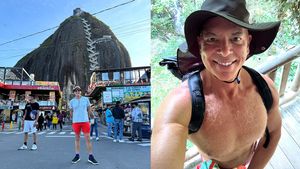Treatment GuideJust DiagnosedSex & DatingAfrican AmericanStigmaAsk the HIV DocPrEP En EspañolNewsVoicesPrint IssueVideoOut 100
CONTACTCAREER OPPORTUNITIESADVERTISE WITH USPRIVACY POLICYPRIVACY PREFERENCESTERMS OF USELEGAL NOTICE
© 2025 Pride Publishing Inc.
All Rights reserved
All Rights reserved
Scroll To Top
By continuing to use our site, you agree to our Privacy Policy and Terms of Use.
Check out the product to be used thoroughly. This is only a brief rundown of what is out there. Read as much as possible about the background and case histories of any filler selected. ' Sculptra (formerly New-Fill). The only FDA-approved product for this procedure, it is made of polylactic acid, the same biodegradable material in dissolvable stitches. As the body absorbs Sculptra, leftover scar tissue creates a kind of matrix that the body fills with its own collagen. Used as a wrinkle filler in Europe since 1999, it was approved by the FDA in August for facial lipoatrophy in HIV patients. Reason for caution: Research on long-term safety is ongoing. Up to half of all patients will experience nodules under the skin, most of which can be felt but not seen and which should eventually go away. Allergic reactions are also possible. Cost: From $750 to $1,500 per treatment, with most patients needing three initial treatments. Severe cases may need up to six. However, if you have highly advanced lipo and are lower income, ask your doctor about the manufacturer's patient-assistance program. Lasts: From 18 to 24 months. About 50% of patients may need touch-ups after a year. Some have reported minimal improvement after multiple treatments. ' Radiesse (formerly Radiance FN). Composed of tiny beads of the substance bone is made of suspended in a sugar-based gel. It functions similarly to Sculptra, prompting the body to create its own soft tissue. Results are more immediate than with Sculptra and fewer procedures are needed. It is FDA-approved for noncosmetic uses only, although approval for lipoatrophy is a future possibility. Problems: Excessive collagen production, counteracted with corticosteroid injections; granulomas; allergic reactions; possible asymmetry in the face; little or no improvement. Cost: From $800 to $1,500 per syringe. Three to five syringes are needed, depending on severity of lipo. Lasts: From 18 to 24 months. ' Bio-Alcamid. The Clinic'estetica in Tijuana, Mexico (just south of San Diego), is the go-to place for this product, which is unavailable in the United States as the FDA conducts its reviews. The clinic calls it the 'first injectable prosthesis.' The injectable gel forms a kind of envelope under the skin that has a thin, hardened outside and a soft inside. It is reportedly permanent and apparently removable. Reason for caution: Anna Love, the director of the clinic, who has no medical license, used to perform all the procedures herself and still injects the occasional face. However, for the past two years her medical director, a dermatologist, has treated almost all patients. The aggressively self-promoting clinic says it has a 100% success rate and vehemently denies knowledge of reports such as those given by a former patient who believes his implant has hardened or by a reputable Los Angeles plastic surgeon who says he has repaired the faces of people who have received botched procedures from the clinic. Worried about safety, U.S. docs often argue that Bio-Alcamid is not available in the United States for good reason and that the Mexican equivalent of the FDA is too lenient. Cost: $4,500 for first 20 cubic centimeters, which is what most people need; $210 for each additional cubic centimeter thereafter. Usually performed in two office visits, six weeks apart. Lasts: Reported to be permanent. ' Liquid silicone (Silikon 1000 or VitreSil 1000). A landmark study finished this year claims to prove the safety and efficacy of the microdroplet technique of injecting this highly purified silicone oil to promote collagen growth in HIV patients. The big debate: Detractors decry liquid silicone for its history of problems, notably migration in the face and the formation of lumps. The research has not proved long-term safety, and problems can arise even 10 years later. But silicone-friendly docs, including the major study's head author, Derek Jones, MD, say the famous problems were caused by egregious contaminants in older forms of silicone as well as poor injection technique and physicians who inserted too much product at once. However, researchers admit that there are risks of bodily rejection and granulomas. Cost: From $750 to $1,000 per treatment. For every step on a scale of lipoatrophy severity'from one to four'you will need three treatments. That is, if you have a severity of three, you will need nine treatments. Lasts: Reported to be permanent. ' Fat grafting. Sydney Coleman, a Manhattan doc known as the 'Michelangelo of fat,' invented a technique called LipoStructure in which your own body fat is harvested and then injected into your face in microdroplets. He theorizes that the high concentration of stem cells in fat helps to permanently repair lipoatrophy. A major plus is that using your own fat reduces complications like bodily rejection, which can occur with synthetic fillers. Reason for caution: While praising his work, physicians criticize Coleman for creating a technique that is hard for others to duplicate. Most report that the injected fat is quickly absorbed and often leaves asymmetrical faces. It can also be difficult to find any fat to transfer in HIV patients, since lipoatrophy can occur in other parts of the body as well, especially the limbs. Cost: From $7,000 to $15,000. Lasts: Permanently, in theory. ' Artecoll. Tiny polyplastic beads suspended in collagen prompt your body to encapsulate the beads upon entry and create its own collagen. Since it is currently unavailable in the United States, HIVers travel to Canada or Rio de Janeiro for this procedure. Side effects: There are reports of 'rubberizing,' possibly caused by excessive scar tissue, as well as permanent granulomas and bodily rejection. Cost: From $800 to $1,100. Lasts: Permanently, in theory. www.canderm.com for more info or to find a doctor. ' Bovine collagen (Zyplast, Zyderm). At $600 to $3,000 per session, depending on the severity of your lipo, this method has proved too costly, since collagen wears off in about three months. Allergic reactions and granulomas are a risk, and the collagen may not feel natural under skin. ' Hyaluronic acid (Restylane, Hylaform). These products last slightly longer than collagen'about three to six months'but not long enough to be cost-effective. Like collagen, they were not designed for the deep-tissue injection necessary to repair lipoatrophied faces. Restylane costs about $2,500 to $4,000 for five cubic centimeters, which is the minimum amount needed.
From our Sponsors
Most Popular
Lexi Love comes out as HIV+ after Trump deletes federal resources
January 23 2025 11:23 AM
Grindr is reminding us why jockstraps are so sexy and iconic
May 02 2025 5:36 PM
BREAKING NEWS: Trump admin moves to end federal HIV prevention programs
March 18 2025 6:10 PM
Trump's orders prompt CDC to erase HIV resources
January 31 2025 5:29 PM
Celebrating Black History Month with our annual African American issue
February 01 2025 3:28 PM
Tyler TerMeer vows to continue to fight for health care for all
January 28 2025 3:00 PM
Discover the power of Wellness in your life
March 26 2025 12:41 PM
Plus: Featured Video
Latest Stories
Dancer. Healer. Survivor. DéShaun Armbrister is all of the above
July 02 2025 8:23 PM
Two right-wing Supreme Court justices signal they may uphold access to PrEP and more
April 21 2025 4:10 PM
Broadway's best raise over $1 million for LGBTQ+ and HIV causes
April 03 2025 7:15 PM
Plus nominated for 2025 GLAAD Media Award
January 22 2025 12:42 PM
'RuPaul's Drag Race' star Trinity K Bonet quietly comes out trans
December 15 2024 6:27 PM
AIDS Memorial Quilt displayed at White House for the first time
December 02 2024 1:21 PM
BREAKING: Supreme Court rules to save free access to preventive care, including PrEP
June 27 2025 10:32 AM
1985: the year the AIDS crisis finally broke through the silence
June 26 2025 11:24 AM
Trump admin guts $258 million in funding for HIV vaccine research
June 03 2025 3:47 PM
500,000 Children at Risk: PEPFAR Funding Crisis
April 08 2025 3:51 PM
The Talk Season 5 premieres this spring with HIV guidance for the newly diagnosed
March 26 2025 1:00 PM
Jess King is here to help you live your happiest, healthiest life yet
March 24 2025 4:35 PM
A camp for HIV-positive kids is for sale. Here's why its founder is celebrating
January 02 2025 12:21 PM
VIDEO: A man living with HIV discusses his journey to fatherhood
June 10 2025 4:58 PM
HRC holds 'die-in' to protest Trump health care cuts
April 28 2025 2:11 PM
Season 4 of The Switch on resilience & radical self-love returns this spring
March 26 2025 12:20 PM
Gerald Garth is keeping people of color happy and healthy through trying times
March 11 2025 3:38 PM
This long-term HIV survivor says testosterone therapy helped save his life.
December 16 2024 8:00 PM
Ricky Martin delivers showstopping performance for 2024 World AIDS Day
December 05 2024 12:08 PM













































































